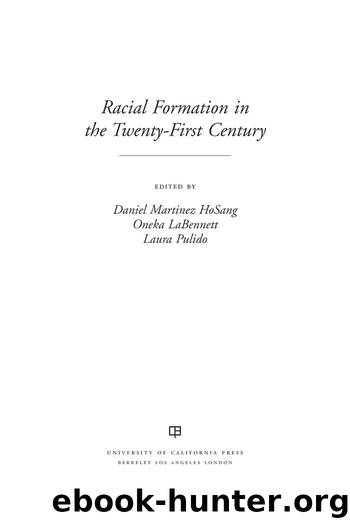Racial Formation in the Twenty-First Century by Daniel Martinez Hosang

Author:Daniel Martinez Hosang [Hosang, Daniel Martinez]
Language: eng
Format: epub
ISBN: 9780520953765
Publisher: University of California Press
Published: 2012-09-01T07:00:00+00:00
THE APPLICANT: CONSTRUCTING THE PERSONAL STATEMENT
While the specific question can differ from school to school, the personal statement generally calls on applicants to provide a personal narrative in which they describe something unique about themselves. Others call on applicants to provide information regarding âdisad vantage overcome.â
In this section, we take autobiographical statements from President Barack Obama to construct a hypothetical personal statement. We do so for four principal reasons: (1) to identify the burdens imposed on applicants by âanti-preference initiativesâ like Proposal 2 and Proposition 209 that are interpreted to require that applicants not include references to race in their personal statements; (2) to explain how racial erasure does not make the application process racially neutral; (3) to illustrate some of the subtle but significant ways in which racial advantages and disadvantages can persist in formally race-free admissions environments; and (4) to reveal that racial formation occurs not only at the level of social structures but also at the level of identity expression. This last point is particularly important given Omi and Winantâs definition of racial formation as a âthe sociohistorical process by which racial categories are created, inhabited, transformed and destroyedâ (Omi and Winant 1994, 55).
In a way, our interest lies in demonstrating how the discursive self-representational choices an individual makes in the context of writing her personal statement can create a particular racial persona, signal specifically how she inhabits her racial identity, effectuate a transformation of that identity, and effectively destroy core parts of her racial sense of self. Understood in this way, the personal statement becomes a significant site for the enactment or performance of race, which is to say, a site for racial formation.
The foregoing raises the question of whether Omi and Winant recognize the performative dimensions of race. And indeed they do. They rightly observe that âwe expect people to act out their apparent racial identities; indeed, we become disoriented when they do notâ (Omi and Winant 1994, 59). Yet Omi and Winant do not explore the implications of this insight for their theory, perhaps because their analysis is largely superstructurally oriented. In this respect, one might read our engagement with how applicants inscribe themselves in their personal statements as an effort to broaden the theoretical terms on which racial formation is understood. We begin this engagement with a âpersonal statementâ based on Barack Obamaâs Dreams from My Father: A Story of Race and Inheritance.7
Download
This site does not store any files on its server. We only index and link to content provided by other sites. Please contact the content providers to delete copyright contents if any and email us, we'll remove relevant links or contents immediately.
| Africa | Americas |
| Arctic & Antarctica | Asia |
| Australia & Oceania | Europe |
| Middle East | Russia |
| United States | World |
| Ancient Civilizations | Military |
| Historical Study & Educational Resources |
Never by Ken Follett(2881)
The Man Who Died Twice by Richard Osman(2300)
Machine Learning at Scale with H2O by Gregory Keys | David Whiting(2292)
Fairy Tale by Stephen King(2070)
Will by Will Smith(2042)
Rationality by Steven Pinker(1765)
The Dawn of Everything: A New History of Humanity by David Graeber & David Wengrow(1571)
The Dark Hours by Michael Connelly(1570)
Principles for Dealing With the Changing World Order: Why Nations Succeed and Fail by Ray Dalio(1373)
Friends, Lovers, and the Big Terrible Thing by Matthew Perry(1328)
A Short History of War by Jeremy Black(1300)
HBR's 10 Must Reads 2022 by Harvard Business Review(1256)
Go Tell the Bees That I Am Gone by Diana Gabaldon(1234)
Can't Hurt Me: Master Your Mind and Defy the Odds - Clean Edition by David Goggins(1227)
515945210 by Unknown(1208)
Fear No Evil by James Patterson(1109)
443319537 by Unknown(1073)
Works by Richard Wright(1018)
Going There by Katie Couric(993)
